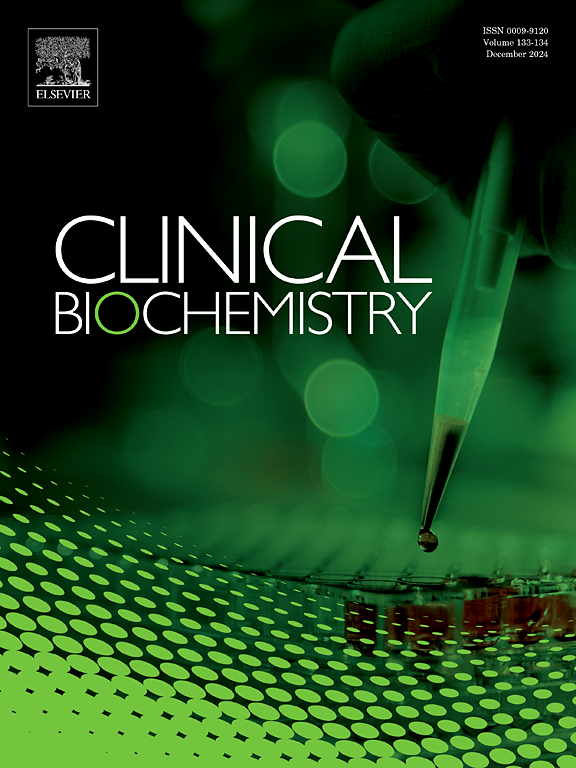Circulating plasma RNY1 as a potential biomarker of breast cancer: a case-control study
IF 2.1
3区 医学
Q2 MEDICAL LABORATORY TECHNOLOGY
引用次数: 0
Abstract
Background
Breast cancer (BC) is the most common cancer in women globally, with early detection playing a crucial role in improving treatment outcomes and survival rates. There is an urgent need for novel biomarkers to aid in early diagnosis, prognosis, and treatment prediction. YRNAs, small non-coding RNAs, have been explored as biomarkers in various cancers, but their role in BC remains under-investigated. This study aimed to explore the expression of circulating plasma YRNAs in BC patients and evaluate their potential as diagnostic and prognostic biomarkers.
Methods
Plasma samples were collected from 50 BC patients and 50 age-matched healthy controls. The expression levels of four YRNAs (RNY1, RNY3, RNY4, and RNY5) were measured using quantitative real-time PCR. We also examined the association between YRNA expression and TNM staging, along with their predictive value for disease-free survival.
Results
RNY1 was significantly upregulated in BC patients compared to healthy controls, while RNY3, RNY4, and RNY5 did not show significant differences. The area under the receiver operating characteristic curve (AUC) for RNY1 was 0.816 (95% CI: 0.732–0.901), demonstrating good discriminatory power. High RNY1 expression correlated with advanced TNM stage and poor prognosis. Additionally, RNY1 expression predicted disease-free survival, as shown by Kaplan-Meier and univariate Cox regression analyses.
Conclusion
The altered expression of RNY1 in BC patients is associated with advanced TNM stage and poor prognosis, suggesting its potential as a diagnostic and prognostic biomarker in BC.
循环血浆RNY1作为乳腺癌的潜在生物标志物:一项病例对照研究
背景:乳腺癌(BC)是全球女性中最常见的癌症,早期发现在改善治疗结果和生存率方面起着至关重要的作用。迫切需要新的生物标志物来帮助早期诊断、预后和治疗预测。YRNAs是一种小的非编码rna,已被研究作为各种癌症的生物标志物,但它们在BC中的作用仍未得到充分研究。本研究旨在探讨BC患者循环血浆中YRNAs的表达,并评估其作为诊断和预后生物标志物的潜力。方法:收集50例BC患者和50例年龄匹配的健康对照者的血浆样本。采用实时荧光定量PCR检测RNY1、RNY3、RNY4、RNY5四种yrna的表达水平。我们还研究了YRNA表达与TNM分期之间的关系,以及它们对无病生存的预测价值。结果:与健康对照组相比,BC患者RNY1显著上调,而RNY3、RNY4和RNY5无显著差异。RNY1的受试者工作特征曲线下面积(AUC)为0.816 (95% CI: 0.732 ~ 0.901),具有良好的鉴别能力。RNY1高表达与TNM分期晚期及预后不良相关。此外,Kaplan-Meier和单变量Cox回归分析显示,RNY1表达预测无病生存。结论:RNY1在BC患者中的表达改变与TNM晚期和预后不良相关,提示其作为BC诊断和预后的生物标志物的潜力。
本文章由计算机程序翻译,如有差异,请以英文原文为准。
求助全文
约1分钟内获得全文
求助全文
来源期刊

Clinical biochemistry
医学-医学实验技术
CiteScore
5.10
自引率
0.00%
发文量
151
审稿时长
25 days
期刊介绍:
Clinical Biochemistry publishes articles relating to clinical chemistry, molecular biology and genetics, therapeutic drug monitoring and toxicology, laboratory immunology and laboratory medicine in general, with the focus on analytical and clinical investigation of laboratory tests in humans used for diagnosis, prognosis, treatment and therapy, and monitoring of disease.
 求助内容:
求助内容: 应助结果提醒方式:
应助结果提醒方式:


